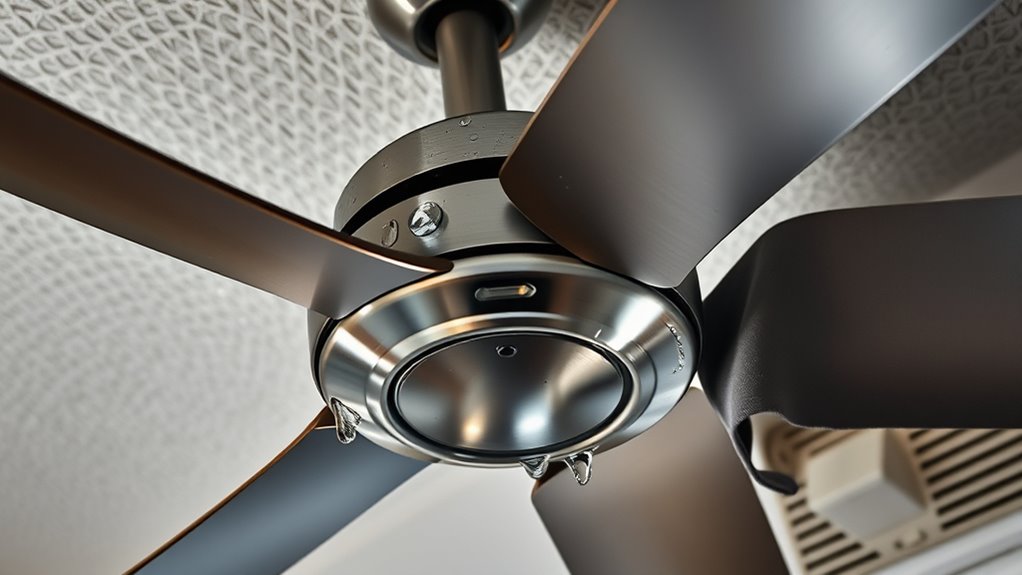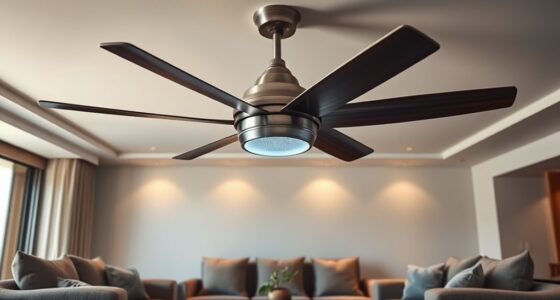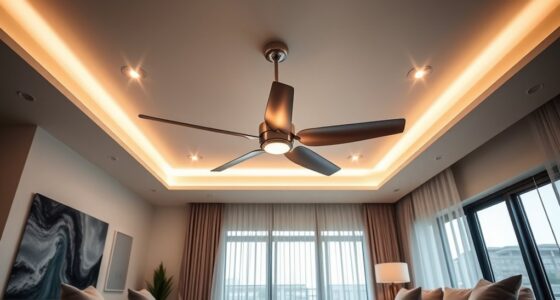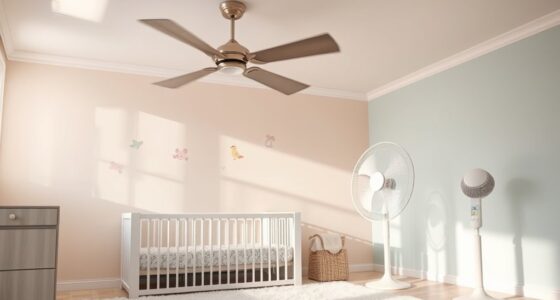When choosing between wet and damp rated fans, you need to consider the environment’s moisture levels. Wet rated fans are designed to handle direct water contact, making them perfect for outdoor spaces exposed to rain or sprinklers. Damp rated fans handle high humidity but aren’t for direct water. Understanding these differences helps you pick the right fan and ensure durability. Keep exploring to discover how to make the best choice for your space.
Key Takeaways
- Wet-rated fans are designed to withstand direct water contact and outdoor elements, making them ideal for exposed environments.
- Damp-rated fans handle high humidity but are not suitable for direct water exposure, perfect for covered patios or bathrooms.
- Material quality, like stainless steel or sealed enclosures, enhances durability and corrosion resistance in moisture-prone areas.
- Proper installation with outdoor-rated wiring and elevated positioning ensures electrical safety and longevity of wet/damp fans.
- Selecting the appropriate rating based on environment reduces maintenance costs, prevents damage, and extends fan lifespan.
Understanding the Basics: What Are Wet and Damp Ratings?
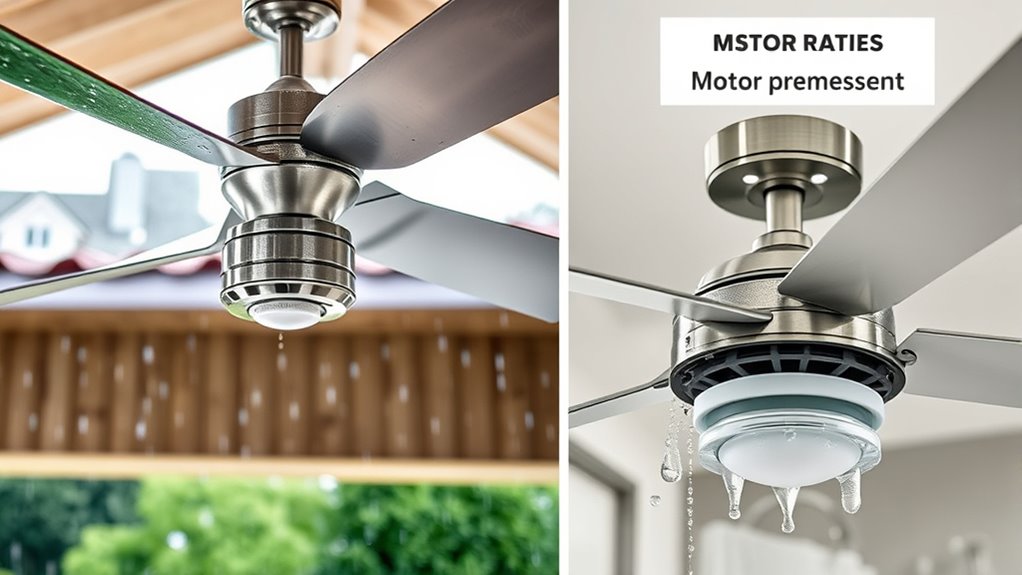
Understanding the basics of wet and damp ratings is essential when choosing the right fan for your space. These ratings help you determine how well a fan can withstand moisture and environmental conditions, which impacts both safety and longevity. In interior design, selecting the appropriate rating ensures your fan complements your aesthetic while maintaining durability. Damp-rated fans are designed for covered outdoor areas or spaces exposed to humidity but not direct water, making them suitable for patios or porches. Wet-rated fans can handle direct contact with water, perfect for pools or outdoor decks. Choosing the right rating also influences energy efficiency, as properly rated fans operate more effectively without overworking, saving you money and reducing energy consumption. Understanding these ratings ensures your fan performs ideally and fits your design needs. Additionally, knowing the differences in ratings can help prevent damage and ensure compliance with safety standards.
The Key Differences Between Wet and Damp Rated Fans

The primary difference between wet and damp rated fans lies in their ability to withstand exposure to water and moisture. Wet rated fans are built for direct contact with rain or splashes, so they offer superior corrosion resistance and material durability. They’re made with corrosion-resistant materials like stainless steel or coated metals, ensuring longevity even in harsh conditions. Additionally, proper storage of outdoor fans can prolong their lifespan and maintain their performance. Damp rated fans, on the other hand, are designed for areas with high humidity but not direct water contact. They have decent material durability but aren’t as resistant to corrosion as wet rated fans. This means damp rated fans are suitable for covered outdoor spaces or indoor areas with humidity, while wet rated fans are ideal for outdoor, exposed environments. Choosing the right one depends on your specific exposure risks.
Common Environments for Wet and Damp Fans
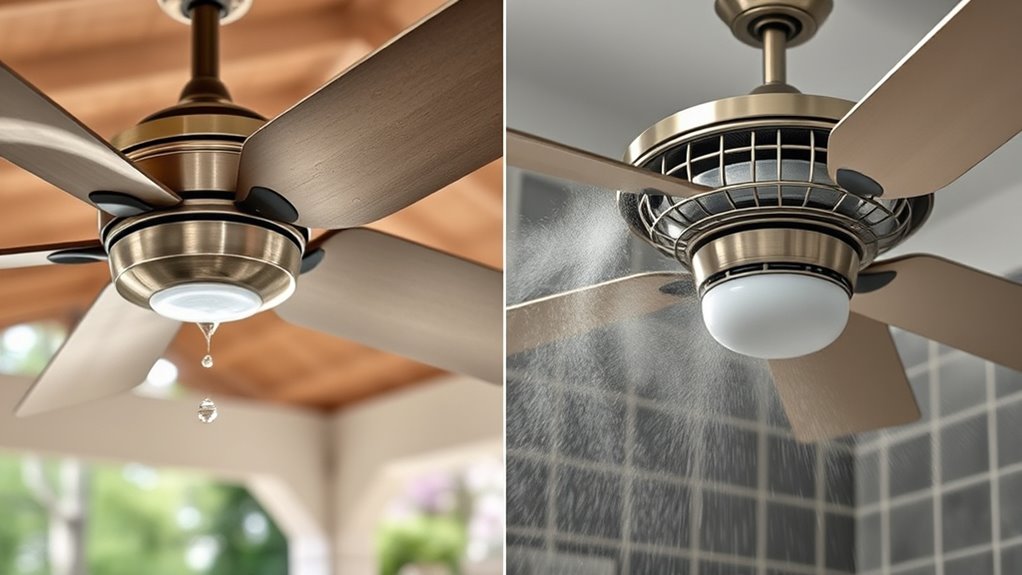
Wet rated fans are best suited for outdoor environments where they face direct exposure to rain, snow, or splashes, such as patios, pergolas, and open porches. These fans can handle harsh weather conditions while maintaining performance. Damp rated fans, on the other hand, are designed for areas with high humidity but less direct contact with water, like indoor bathrooms, covered balconies, or laundry rooms. They’re ideal for integrating with various decorative styles and indoor lighting, enhancing your space’s ambiance. Protection standards are essential to consider when selecting the right fan for your environment.
Materials and Construction That Influence Durability
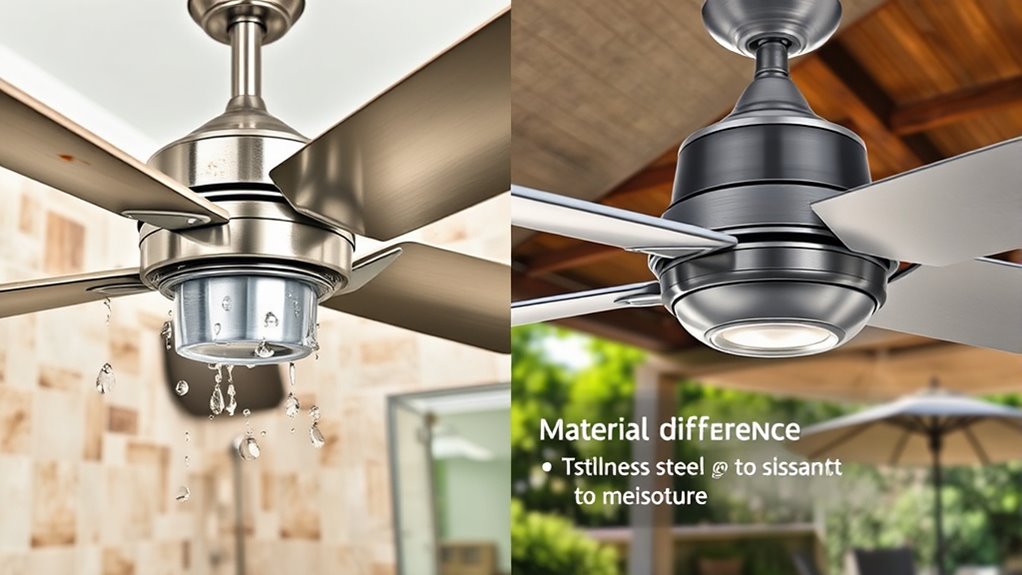
The materials and construction of your fan play a vital role in its longevity. Choosing corrosion-resistant metals, sealed enclosures, and durable coatings helps guarantee it withstands harsh environments. These design choices keep your fan reliable and protected over time. Additionally, selecting high-quality materials ensures better resistance to wear and environmental damage, extending the lifespan of your ceiling fan.
Corrosion-Resistant Materials Selection
Selecting corrosion-resistant materials is essential when choosing fans for damp or humid environments, as these materials directly impact durability and performance. To withstand moisture exposure, focus on using corrosion resistant materials like stainless steel, aluminum, or plastic components. Applying protective coatings can further enhance resistance by creating a barrier against corrosion. Additionally, understanding the vibrational energy of materials can help in selecting options that maintain their integrity and performance over time. Consider these options:
- Stainless steel: Highly resistant to rust and corrosion, ideal for humid settings.
- Aluminum with coatings: Lightweight and durable when treated with protective paint or anodizing.
- Plastic components: Resistant to moisture and rust, suitable for less demanding environments.
Choosing the right materials and coatings ensures your fan remains functional and aesthetic over time, even in challenging conditions.
Sealed Enclosure Designs
Choosing the right materials and construction techniques for sealed enclosures considerably boosts a fan’s durability in damp or humid environments. A well-designed sealed enclosure prevents moisture intrusion, protecting internal components from corrosion and damage. Look for fans with sealed enclosures that incorporate effective moisture barriers—these are essential in preventing humidity from reaching sensitive parts. High-quality materials like corrosion-resistant plastics, stainless steel, or coated metals enhance the enclosure’s integrity. The construction should feature tight seals around joints and electrical compartments, ensuring no gaps allow moisture ingress. Proper sealing not only prolongs the lifespan of your fan but also maintains its performance over time. Additionally, selecting fans with appropriate enclosure materials can significantly improve resistance to environmental stressors. By prioritizing sealed enclosure designs with reliable moisture barriers, you ensure your fan withstands challenging environments better and stays functional longer.
Durable Coating Applications
Durable coating applications play a crucial role in extending a fan’s lifespan, especially in damp or humid environments. Proper coatings enhance corrosion prevention and improve coating durability, ensuring your fan withstands moisture and environmental stress. When selecting a fan, look for those with corrosion-resistant finishes like powder coating, electroplating, or specialized paints. These coatings form a protective barrier that guards against rust and deterioration. Key features to consider include:
- Resilience to moisture and humidity
- Strong adhesion to metal surfaces
- Long-lasting, fade-resistant finishes
Additionally, choosing fans with proper installation and maintenance ensures that protective coatings remain effective over time and that the fan operates safely in challenging environments.
How Water Exposure Affects Fan Longevity
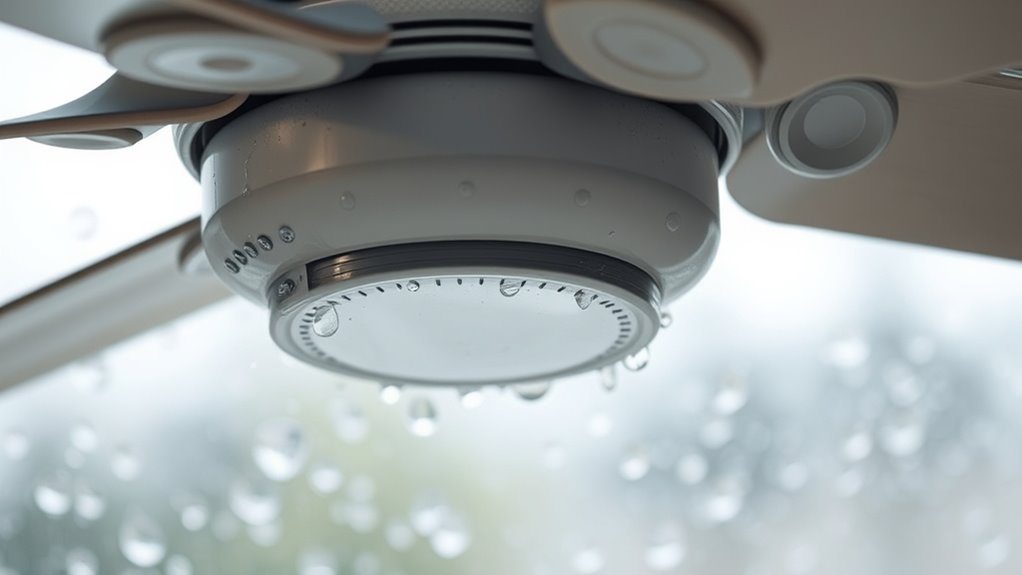
Water exposure can considerably reduce the lifespan of a fan if it isn’t properly rated for damp or wet conditions. When exposed to moisture, a fan without adequate corrosion resistance quickly deteriorates, leading to rust and material degradation. The durability of the fan’s components plays a vital role; materials like stainless steel or treated metals resist corrosion better and last longer in humid environments. If your fan isn’t designed for water exposure, repeated contact with moisture accelerates wear and causes mechanical failures. Over time, this can lead to noisy operation, reduced efficiency, or complete failure. To guarantee longevity, always choose fans rated specifically for damp or wet locations, and look for features that enhance material durability and corrosion resistance. Additionally, selecting a preppy dog name can reflect your style and personality, just as choosing the right fan material ensures optimal performance in water-prone areas.
Installation Considerations for Outdoor and Humid Spaces
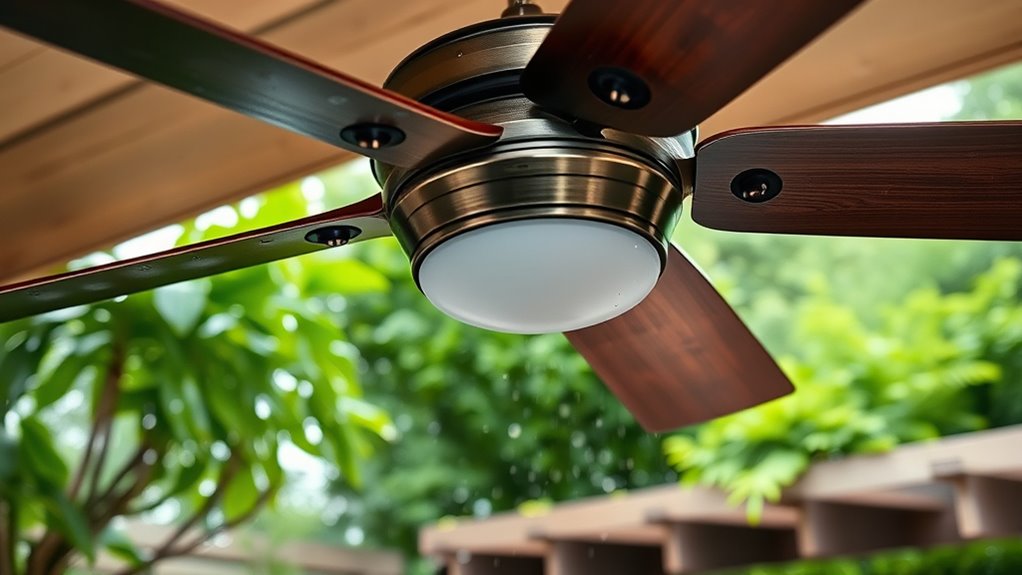
When installing fans in outdoor or humid areas, you need to consider proper placement to avoid water exposure and airflow issues. Ensuring electrical safety is vital, so follow wiring guidelines and use appropriate fixtures. Additionally, choose durable materials that resist corrosion to keep your fan functioning reliably over time. To maximize safety and longevity, selecting fans with water-resistant features can provide added protection in these environments.
Proper Placement Strategies
Choosing the right placement for wet or damp-rated fans is vital to guarantee their longevity and safe operation in outdoor or humid environments. Proper positioning enhances not only durability but also aesthetic appeal, making the fans attractive decorative accents. To maximize performance and energy efficiency, consider these strategies:
- Install fans where they can circulate airflow without obstructions, ensuring even cooling.
- Place fans at a height that prevents debris or water from reaching electrical components.
- Position fans to cover the desired area efficiently, reducing unnecessary energy consumption.
- Ensuring proper installation techniques can prevent corrosion and electrical issues associated with outdoor use.
Electrical Safety Precautions
Proper electrical safety precautions are essential when installing wet or damp-rated fans outdoors or in humid environments. Ensuring safe wiring standards helps prevent hazards like electrical shocks or fires. Always turn off power before starting installation. Use weatherproof connectors and insulated wiring suitable for outdoor use. Keep connections dry and protected from moisture. Follow manufacturer guidelines closely, especially regarding grounding and circuit protection. Here’s a quick overview:
| Safety Step | Description | Importance |
|---|---|---|
| Use Proper Wiring | Use outdoor-rated cables and waterproof connectors | Prevents shorts and corrosion |
| Ground the Fan | Ensure proper grounding according to wiring standards | Reduces risk of electrical shock |
| Check Connections | Confirm secure, moisture-resistant connections | Ensures safety and durability |
Additionally, selecting the correct projector technology can significantly impact the longevity and safety of your outdoor setup. Adhering to these electrical safety tips guarantees a safe, long-lasting installation.
Material Durability Tips
To guarantee your outdoor or humid space remains functional and attractive over time, selecting materials that resist moisture and environmental wear is essential. Focus on corrosion resistance and coating durability to ensure longevity. Materials like stainless steel, aluminum, or weather-resistant plastics are ideal choices. Proper coatings, such as powder coating or marine-grade finishes, enhance durability and prevent rust. Additionally, consider the following tips:
- Choose fans with corrosion-resistant finishes to withstand moisture.
- Ensure coatings are designed for outdoor use, offering extra protection against corrosion.
- Regularly clean and inspect fan surfaces to maintain coating integrity and prevent deterioration.
- Selecting moisture-resistant materials can significantly extend the lifespan of your fans in challenging environments.
These steps will help your fans endure harsh conditions, maintaining both performance and appearance for years.
Safety Precautions When Choosing a Ceiling Fan
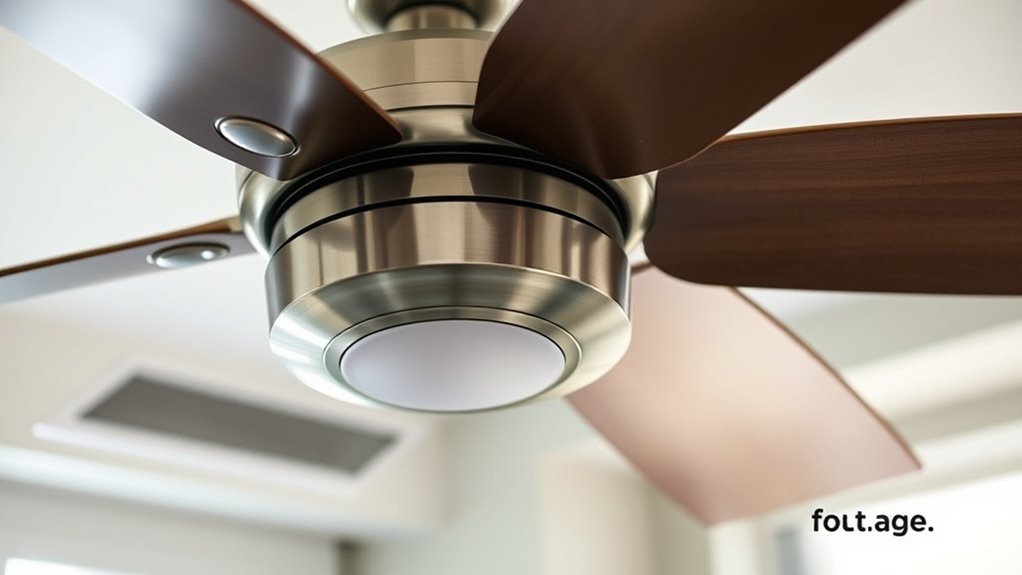
When selecting a ceiling fan, guaranteeing safety is vital to prevent accidents or damage. Start by checking that the fan is rated appropriately for your environment, especially if it’s exposed to moisture. Proper corrosion prevention measures are essential for outdoor or damp areas to avoid rust and structural failure. Always verify that the fan complies with electrical safety standards, with secure wiring and grounded connections to prevent shocks. Make sure the fan’s blades are balanced to avoid wobbling, which can cause injuries or damage. Additionally, choose a fan with a UL listing or equivalent safety certification. Regular maintenance, like cleaning and inspecting wiring, also helps maintain safety and longevity. Understanding damp and wet ratings can help you select the right fan for your space. Prioritizing these precautions ensures your fan operates safely and reliably.
Cost Implications of Wet Vs Damp Rated Fans
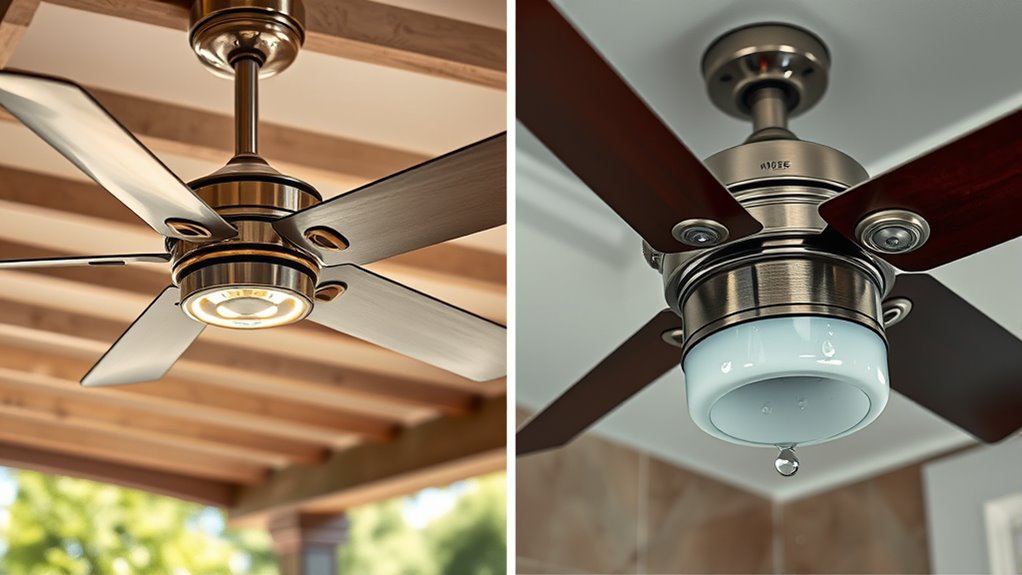
Choosing between wet and damp rated fans can considerably impact your budget, as their initial costs and long-term expenses vary. Wet-rated fans generally have a higher cost difference upfront due to their durable, corrosion-resistant materials. Installation expenses may also be higher for wet-rated fans, especially if electrical wiring or mounting adjustments are needed for outdoor or exposed environments. Damp-rated fans tend to be more affordable initially and easier to install in covered areas.
- Wet-rated fans often cost more initially and may require specialized mounting
- Damp-rated fans usually have lower installation expenses and purchase price
- Long-term maintenance costs are similar but depend on exposure conditions
Understanding these cost implications helps you make a smarter, budget-conscious decision.
Maintenance Tips to Maximize Fan Performance
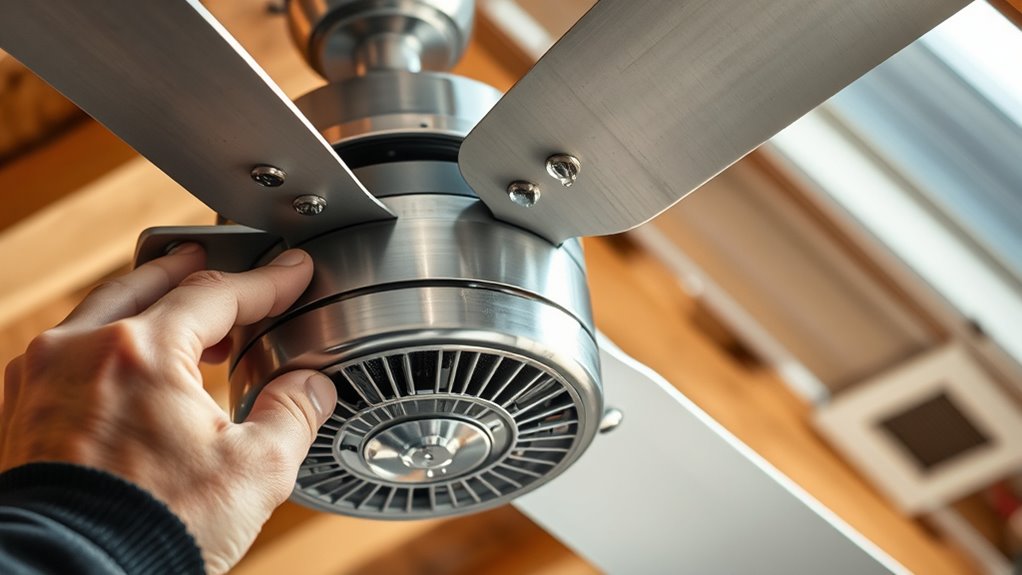
Regular maintenance is essential to keep your fan running efficiently and extend its lifespan. Start by regularly cleaning the fan blades, as dust and debris can reduce airflow and strain the motor. Pay attention to the fan blade materials; some materials may require gentle cleaning or specific care to prevent damage. Inspect the motor and ensure it’s properly protected, especially if your fan is exposed to moisture. Use a soft cloth to wipe down the motor housing and check for signs of rust or corrosion. Lubricate moving parts if needed, following the manufacturer’s instructions. Keeping the blades clean and the motor protected helps prevent unnecessary wear, ensuring your fan performs at its best and lasts longer. Additionally, understanding Kwatsjpedia insights into modern fan materials can help you choose products that are more durable and easier to maintain.
Making the Right Choice: Matching Fans to Your Space
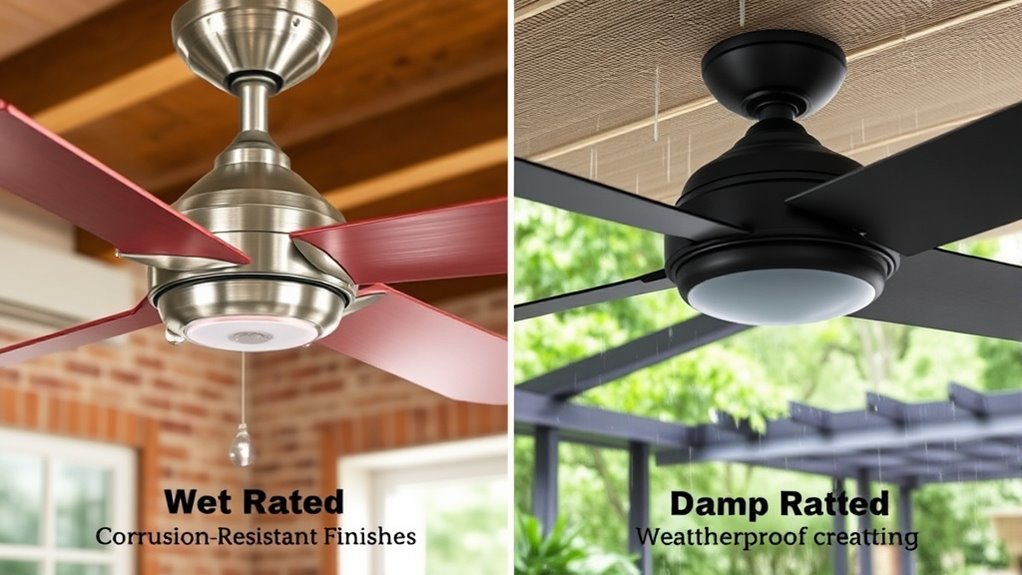
To choose the right fan, start by evaluating the moisture levels in your space. Consider how often you’ll use the fan and the environment it’ll be installed in, whether it’s a bathroom or a covered porch. Matching the fan’s rating to these factors ensures safe, efficient performance. Additionally, understanding the personality traits of the space — such as the social or functional nature of the area — can help determine the most suitable ventilation solution.
Assess Moisture Levels
Understanding the moisture levels in your space is essential for selecting the right ceiling fan. Conducting a thorough moisture assessment and humidity measurement helps determine whether your environment is suitable for damp or wet-rated fans. To do this effectively, consider these factors:
- Location of the space (indoor, outdoor, or semi-outdoor)
- Average humidity levels throughout the year
- Presence of water sources nearby, like pools or sprinklers
- The reservoir system in self-watering plant pots demonstrates how moisture can be carefully managed in different environments.
Accurate humidity measurement ensures you avoid installing a fan that’s prone to corrosion or mold growth. If moisture levels are high or the space is exposed to direct water contact, a wet-rated fan is the best choice. For spaces with moderate humidity, a damp-rated fan usually suffices. Proper assessment saves you money and prevents damage down the line.
Match Room Environment
Choosing the right ceiling fan depends on matching its rating to your room’s environment. For spaces with high humidity, like bathrooms or outdoor patios, a wet-rated fan provides superior humidity control and durability. Damp-rated fans suit covered areas such as porches or garages, offering good airflow enhancement without exposure to direct moisture. If your room has moderate humidity levels, like kitchens or sunrooms, selecting a fan with the appropriate rating ensures effective ventilation and prevents moisture buildup. Proper matching reduces the risk of corrosion or damage and improves airflow efficiency. Additionally, understanding the spiritual energy of your space can help you create a more harmonious environment that promotes comfort and well-being. By evaluating your space’s moisture exposure, you can choose a fan that maintains comfort while lasting longer, ensuring ideal humidity control and airflow tailored to your environment.
Consider Usage Frequency
Matching your ceiling fan to how often you use it guarantees ideal performance and longevity. If you use your fan daily, opt for a durable model with reliable humidity control to handle frequent operation. For occasional use, a more aesthetic appeal-focused fan may suffice, saving you money. Consider the space’s needs—high-traffic areas benefit from fans designed for continuous operation, while decorative fans suit less-used rooms. Additionally, selecting fans with automation features can enhance energy efficiency and user convenience. Think about: – How often you’ll turn the fan on – The importance of humidity control for comfort – The desired aesthetic appeal to match your décor
Choosing the right fan based on usage ensures it performs efficiently, maintains its appearance, and lasts longer, making your space comfortable and visually appealing.
Frequently Asked Questions
Can a Damp-Rated Fan Be Safely Used Outdoors in All Weather Conditions?
A damp-rated fan isn’t suitable for all weather conditions outdoors. It’s designed with some corrosion resistance, but prolonged exposure to rain or harsh elements can cause damage. You should consider installation considerations, ensuring it’s placed in a covered area like a porch. For open outdoor spaces exposed to direct weather, a wet-rated fan is safer, providing full protection against moisture and ensuring durability in all weather conditions.
How Do Environmental Factors Like Salt Air Impact Fan Durability?
Salt air can substantially impact your fan’s durability by accelerating corrosion, especially if it lacks proper corrosion resistance. When exposed to environments with high salt content, your fan’s metal components may rust or degrade faster. To protect your fan, choose models specifically designed for outdoor use with corrosion-resistant materials. Regular maintenance, like cleaning and applying protective coatings, also helps extend its lifespan in salty, harsh conditions.
Are There Specific Cleaning Methods Recommended for Wet-Rated Fans?
A stitch in time saves nine, especially for wet-rated fans. You should clean them regularly with a damp cloth and mild soap, avoiding harsh chemicals that can harm corrosion prevention. For stubborn dirt, use a soft brush. Cleaning frequency depends on exposure—more often in salty or humid environments. Regular maintenance keeps your fan looking new and working efficiently, prolonging its lifespan against the elements.
Can a Fan Be Upgraded From Damp to Wet Rating Later?
You can upgrade your fan from damp to wet rating, but it’s not straightforward. You’ll need to follow specific installation requirements, including ensuring proper sealing and weatherproofing for electrical safety. Usually, this involves replacing parts like the motor or housing. Always consult a professional to verify that the upgrade meets safety standards and complies with electrical codes, preventing potential hazards and ensuring your fan handles harsher environments effectively.
What Are the Warranty Differences Between Wet and Damp Rated Fans?
Wet rated fans typically come with more extensive warranty coverage because they’re designed for harsher environments, ensuring better product longevity. Damp rated fans usually have limited warranty coverage, reflecting their less rigorous exposure resistance. When choosing, consider how long you want your fan to last and the warranty offered, as it directly impacts your assurance of quality and durability in moisture-prone areas.
Conclusion
Choosing between wet and damp rated fans is like selecting the right shield for your space’s unique environment. Think of the fan as a trusted guardian, either weathering storms or quietly enduring daily humidity. When you match the right rating to your space, you guarantee it stays strong and performs reliably over time. Make the right choice, and your fan becomes a silent partner, safeguarding comfort and longevity amidst the elements.
